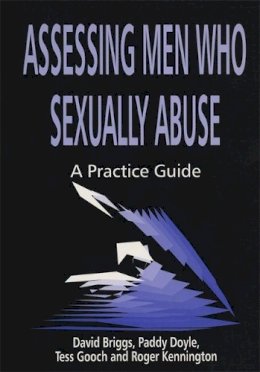
Assessing Men Who Sexually Abuse: A Practice Guide
Roger Kennington
Providing practical guidance on the best way to assess sexual abusers, this book fuses contemporary theory with an awareness of the subjective nature of the work. Assessment in various (clinical, legal and statutory) settings is considered and an overview of assessment methods is presented along with a detailed exposition of techniques. Previously-neglected aspects of work with sexual abusers are dealt with and links are made with fundamental aspects of risk assessment.
'A thorough and detailed overview of all the issues associated with this area of work, and in doing so provide[s] a useful and concise starting point for any newcomer to the field. The book appears to touch on all (or at the very least the key) areas of assessing those who sexually abuse. The reader can choose to read the whole book, concisely compacted into 160 pages and gain a good insight into this whole area. Alternatively, one could delve into the chapters or sections that are of primary interest and still obtain a good overview of that area and come away with a number of references for further information.'
- Forensic Update
Product Details
About Roger Kennington
Reviews for Assessing Men Who Sexually Abuse: A Practice Guide
Community Care Written by practitioners for practitioners, the book is readable and information very accessible. I feel I was expertly guided through a maze and was in very safe hands. This book comes very highly recommended. It will be essential reading for practitioners who have contact with sex offenders and their families. It will also be useful to other readers who want some idea of the challenges that working with sex offenders can present.
Probation Journal There is now an increasing public awareness about sexual offenders. There have been several recent examples of moral outcry when individual offenders have been released from custody. This confusing and challenging situation makes it increasingly necessary for a wide range of professionals to be aware of the practice issues in working with sexual offenders, to which this book provides a very good, clear guide. The authors are all specialist practioners working in the north of England and the book draws on their practice knowledge and experience. It is their aim to give practioners guidance which will enable them to work towards reducing the risk of re-offending by sexual offenders. The book is enriched by examples from their own practice which clearly illustrate the dilemmas of practice with offenders and the stress which workers may experience. There is a particularly helpful section on interviewing techniques and dos and don'ts. The issue of confidentiality is addressed, as are the difficulties which may occur with transference between worker and client. The various contexts in which the assessment of offenders may be required are very clearly and thoroughly described; the mental health court (both civil and criminal proceedings) and child protection contexts are well and fully explained. This will be of particualar use to the non-specialist reader who may be involved in working in one of these areas of practice. This is an excellent book written by experienced, skilled practioners who emphasize that their 'primary duty is the protection of the public'. The commitment of the authors to this task shines through in this book and produces a thoroughly interesting and useful text for both specialist and non-specialist practioners.
International Social Work David Briggs and colleagues have provided a valuable addition to the recent literature on the assessment of sexual offenders, particularly as a practical guide to risk assessment by experienced UK practitioners. The basis of the book's success is to be found in its clear structure and overall accessibility, achieved by approaching the subject without unnecessary jargon. This is a practical book for practitioners, and managers who wish to be better informed… this book is clearly set out, easy to read and written by people who know their field and present their knowledge well. The primary purpose of the book is as an introduction for the less experienced who wish to be better informed, an essential contribution as recognition of the importance of working with offenders is developing across a broad range of practice settings. Those more familiar with the field may also benefit from the different perspectives it includes and the opportunity it offers to review their own practice.
BASPCAN British Association for the Study and Prevention of Child Abuse and Neglect [It contains] many pearls of wisdom from years of practice. I have already begun recommending it to colleagues. The layout of the book ensures that it can fulfil its purpose of being a practice guide extremely effectively, it provides a wealth of material, supportive advice and resources... Our task in this, at times, daunting area of work becomes substantially more achievable.
NAPSAC (National Association for the Protection from Abuse/Sexual Abuse of Adults and Children with Learning Disabilities)
